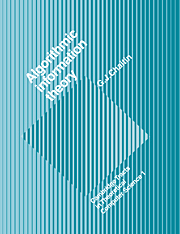Book contents
1 - Introduction
Published online by Cambridge University Press: 23 November 2009
Summary
More than half a century has passed since the famous papers GÖDEL (1931) and TURING (1937) that shed so much light on the foundations of mathematics, and that simultaneously promulgated mathematical formalisms for specifying algorithms, in one case via primitive recursive function definitions, and in the other case via Turing machines. The development of computer hardware and software technology during this period has been phenomenal, and as a result we now know much better how to do the high-level functional programming of Godel, and how to do the low-level machine language programming found in Turing's paper. And we can actually run our programs on machines and debug them, which Gödel and Turing could not do.
I believe that the best way to actually program a universal Turing machine is John McCarthy's universal function EVAL. In 1960 McCarthy proposed LISP as a new mathematical foundation for the theory of computation [McCARTHY (I960)]. But by a quirk of fate LISP has largely been ignored by theoreticians and has instead become the standard programming language for work on artificial intelligence. I believe that pure LISP is in precisely the same role in computational mathematics that set theory is in theoretical mathematics, in that it provides a beautifully elegant and extremely powerful formalism which enables concepts such as that of numbers and functions to be defined from a handful of more primitive notions.
Simultaneously there have been profound theoretical advances. Gödel and Turing's fundamental undecidable proposition, the question of whether an algorithm ever halts, is equivalent to the question of whether it ever produces any output.
- Type
- Chapter
- Information
- Algorithmic Information Theory , pp. 1 - 5Publisher: Cambridge University PressPrint publication year: 1987

